Blind Recognition Algorithm of Convolutional Code via Convolutional Neural Network
Abstract
Pointing at the vexed question of blind recognition in the convolutional code class, this paper proposes a convolutional code blind identification method via convolutional neural networks (CNNs). First, this algorithm uses the traditional method to generate different convolutional codes, and the feature extraction algorithm adopts the theorem of Euclid’s algorithm. Then, the input signal is loaded to the CNN; next, the feature is extracted by convolutional kernel. Finally, the Softmax activation function is applied to full-connection layer network. After the input signals pass through the above layers, the system classifies the signals. The research results indicate that the presented algorithm has improved the recognition performance of code length and rate. For different convolutional codes with parameters of (5, 7), (15, 17), (23, 35), (53, 75), and (133, 171) and similar convolutional codes with parameters of (3, 1, 6), (3, 1, 7), (2, 1, 7), (2, 1, 6), and (2, 1, 5), the recognition rate of parameter classification can reach 100% at signal-to-noise ratio (SNR) of 3 dB.
1. Introduction
To ensure that the channel coding performance is close to approximate the Shannon limit, in 1955, P. Elas [1] proposed a promising encoding method, which is named the convolutional code. Compared with linear block codes, convolutional codes have the advantage that it can obtain higher coding gain than linear block codes in the same complexity. Convolutional codes are a kind of error correction coding with better performance and lower complexity of encoding and decoding. At present, as one of the supreme significance coding methods, convolutional code’s blind recognition has strong application prospects in satellite correspondence [2], unmanned aerial vehicle (UAV) measurement and control [3], deep space communication [4], mobile communication [5], underwater acoustic communication [6], and other digital communication systems and is even adopted into some wireless communication standards [7]. Blind distinction of convolutional codes is a key technology in intelligent communication and information countermeasures. It can be foreseen a growing number of digital communication systems utilizing convolutional codes will advent down the line. In terms of noncooperative correspondence realms, convolutional code parameter recognition is a problem we should solve immediately.
Therefore, in the realm of noncooperative correspondence, the blind distinction of convolutional coding has been a crucial problem in recent years. From the published literature, there are many literatures on parameter distinction of linear block codes, cyclic codes, BCH codes, and Turbo codes and low-density Parity-Check (LDPC) codes; so far, there are few research studies on blind identification of convolutional code parameters in the world. In view of the poor fault tolerance of the current blind identification methods of linear block code arguments, literature [8] proposed a blind recognition method for linear block code arguments on account of the iterative column elimination method, which uses the dual code word for elementary line transformation recognition check matrix. The proposed method has good fault tolerance performance, but it is complex to calculate and has poor recognition effect for high rate linear block code parameters. Literature [9] proposed an algorithm for parameter identification based on the verification relation of cyclic codes under soft decision. For cyclic codes with different polynomials generated under different code lengths, the algorithm can correctly identify their code lengths, synchronization starting points and generated polynomials under certain signal-to-noise ratio (SNR) and certain amount of code word interception, but the recognition rate is poor when the SNR is poor. Literature [10] proposed a shortened BCH code recognition method under soft decision conditions, which can both recognize shortened BCH codes and apply to the original BCH codes. A complete method is proposed for the distinction of code size, original multinomial, and generating multinomial; however, computational complexity of this algorithm is high.
For random interleaver of Turbo code, literature [11] proposed an algorithm for estimation by taking advantage of accepted soft-decision series and realizes the estimation of interleaver position. However, if the RSC parameter is unknown or the estimation is wrong, the algorithm is invalid. Literature [12] proposed a moment-multiplication-rank reduction algorithm, which restores the code length and starting point of LDPC code in the case of low probability of error. To achieve the same recognition effect, the proposed algorithm can save at least 20% of the data. However, its computational complication is comparatively high. Literature [13] proposed a unified expression method for solving the generating matrix of master and extended convolutional codes. The corresponding relation model between the algorithm and the polynomial coefficient of the extended encoder is constructed. Fast calculation of the extended convolutional code generation matrix can be realized by the theorem, and provide convenience for traversing and rebuilding the deleted convolutional code of deletion pattern and master code generation matrix. However, its computational complexity is relatively high. Literature [14] proposed a fast blind recognition method of (2, 1, m) convolutional codes with better fault tolerance, aiming at the problems of existing convolutional code recognition methods with low fault tolerance, known coding parameters and large amount of computation. In the case of unknown coding parameters, the coding parameters can be quickly identified according to the detection result of the estimated value of the check sequence. But its recognition accuracy needs to be further improved. Literature [15] proposed a new approach via the improved Walsh–Hadamard conversion, analyzes the shortcomings of the existing approach via Walsh–Hadamard conversion to directly solve the equations, and obtains the polynomial matrix generated by (n, 1, m) convolutional code. But other types of convolutional codes are not recognized. From the above analysis, it can be seen that there are few algorithms for convolutional code parameter recognition alone, while convolutional codes are more and more widely used in practical engineering. Literature [16] proposes a channel code recognition algorithm based on two types of neural networks, including bidirectional long and short term memory (BiLSTM) and convolutional neural network (CNN). The received signals are first preprocessed into BiLSTM and then processed by CNN. It inherits the advantages of BiLSTM and CNN, respectively. It can effectively recognize convolutional codes, LDPC codes, and polarization codes, but the extracted features are not obvious, and the recognition accuracy is not high under low and high SNR. Literature [17] proposes a channel code recognition algorithm based on deep learning to automatically extract features to avoid complex calculations. Three convolutional codes are considered candidate code words. It can recognize convolutional codes effectively. But the discernible convolutional codes have a single category and a small number. The recognition accuracy is not high at low SNR. Literature [18] presents a recognition method based on multitask deep convolutional neural network (MT-DCNN). The method can automatically identify baseband in-phase ECC type and quadrature phase (IQ) data without relying on any traditional demodulator. Experimental results show that the architecture can identify the target accurately. It can recognize 4 channel codes, but the recognition accuracy is not high at low SNR. For noncooperative communication, convolutional code parameter recognition is a hard challenge to be settled imminently.
Accordingly, this paper proposes a convolutional code parameter blind identification method via CNN. This algorithm first generates convolutional codes with different parameters through traditional coding methods, and feature extraction algorithm adopts the theorem of Euclid’s algorithm. Second, CNN is introduced to isolate characteristic of convolutional codes with different parameters and send them into the CNN for training, thus realizing the classification and recognition of different parameters of the same type of convolutional codes. The results of these experiments demonstrate that the proposed method is available and has good fault tolerance. Simulation results show that the suggested method achieved strong performance, indicating its high efficiency and strong fault tolerance.
2. Method Introduction of the Blind Identification System of Convolutional Code
The convolutional code blind recognition system model is shown in Figure 1. The algorithm first generates convolutional codes with different parameters through traditional coding. This paper focuses on convolutional codes whose parameters are (5, 7), (15, 17), (23, 35), (53, 75), and (133, 171) and similar convolutional codes with parameters of (3, 1, 6), (3, 1, 7), (2, 1, 7), (2, 1, 6), and (2, 1, 5). Second, CNN is introduced, which extracts features of the convolutional codes encoded with different parameters and sends them to CNN for drilling. After passing through each layer of CNN, the classification of convolutional codes is realized. Finally, the classification and parameter recognition of convolutional codes with different parameters are realized. The effect of various SNR and various NN about the classification and recognition accuracy of convolutional codes is contrasted. The effect of various code word numbers, various code word lengths, and various code rates on the algorithm is also analyzed.

3. Coding Process of Convolutional Codes
Half of construction of convolutional code encoder is expressed in Figure 2.
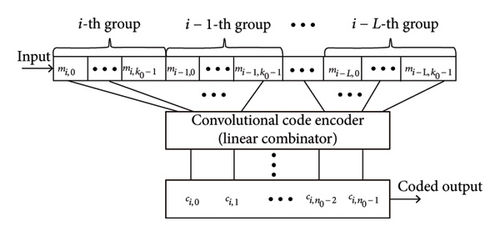
k is the number of information bits and L + 1 is the constraint length. It shows each symbol is the outcome of linear combination of k ∗ (L + 1) data. Similarly, the encoded course of convolutional code is represented in the form of matrix product.
- 1.
Parameter initialization:
()() - 2.
For i, define qi(x), ri(x), which satisfies
() - 3.
Recursive algorithm:
()() - 4.
Conditions precedent:
()
4. Generation of the Dataset
The dataset utilized in this paper is produced by the traditional coding method, and the theorem of Euclid’s algorithm is used to extract important features. Simulation dataset is produced in Matlab2020a, and white Gaussian noise is added. The dataset consists of 2048 samples, 100,000 data points, and 10 convolutional code-encoded signals.
5. CNN
CNNs can be self-coded and combined with preformed and fine-tuned neural networks. The construction diagram of CNN is displayed in Figure 3. This paper puts forward an algorithm on account of CNN, which consists of 7 NN layers. This paper is upon five existed NN methods, called deep neural networks (DNNs) [19], long short-term memory (LSTM) [20], ResNet [21], Attention [22], and recurrent neural network (RNN) [23].


A complete convolutional layer operation is shown in Figures 5. In the first part, multiple convolutions are computed in parallel to produce a set of linear activation responses. Each linear activation response in Part 2 will be augmented by a nonlinear activation function. In the third part, we take advantage of the pooling function to further tune output of this layer.
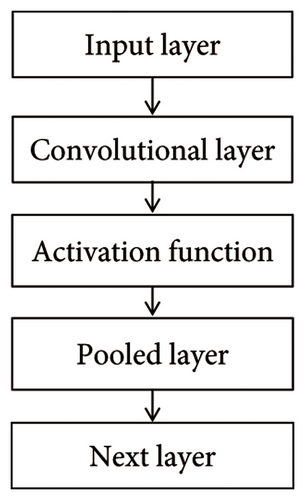
-
Presuppose: the learning rate is ηk, the initial parameter is θ, the momentum parameter is α, and the initial velocity is v.
-
Process: SGD update in the Kth training iteration.
-
While not meet training stop requirement, do
-
Sample a small batch of samples including m specimen {x(1), x(2), …, x(m)} ochastically from the training set, where the target output corresponding to xi is yi;
-
Temporary renewal:
-
Calculate the gradient of small batch data:
() -
Calculate speed update:
() -
Update parameter:
() -
End while
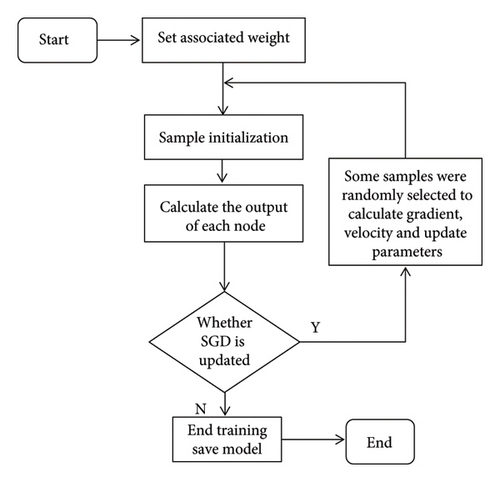
As shown in Tables 1 and 2, labels are applied to the obtained 5 types of channel coding datasets, such as 5 common convolutional codes and 5 similar convolutional codes, which is advantageous to proper estimation of identification results. The input data of the neural network are noisy information fragments, and the CNN training samples in the paper are convolutional codes, accounting for 60%, test samples for 20%, and verification sets for 20%. The composition of the entire training dataset has been thoroughly verified, as shown in Table 3.
| Convolutional code | The label |
|---|---|
| Convolutional code (5, 7) | 10000 |
| Convolutional code (15, 17) | 01000 |
| Convolutional code (23, 35) | 00100 |
| Convolutional code (53, 75) | 00010 |
| Convolutional code (133, 171) | 00001 |
| Convolutional code | The label |
|---|---|
| Convolutional code (3, 1, 6) | 10000 |
| Convolutional code (3, 1, 7) | 01000 |
| Convolutional code (2, 1, 7) | 00100 |
| Convolutional code (2, 1, 6) | 00010 |
| Convolutional code (2, 1, 5) | 00001 |
| Training data set | Training set | Validation set | Test set |
|---|---|---|---|
| 1 | 60% | 20% | 20% |
| 100,000 | 60,000 | 20,000 | 20,000 |
6. Simulation Result
6.1. Performance Comparison of Network Models
First, the proposed model was compared with alter neural networks DNN, LSTM, ResNet, Attention, and RNN. The model used datasets of 100,000 samples for training, and the SNR ranged from −20 to 20 dB. Exactly as Figure 7, this way was superior than other NNs in the side between maximum precision and fault-tolerant capacity. CNN can reach 100%, but DNN, LSTM, ResNet, Attention, and RNN networks only had identification precision of 92%, 90%, 88%, 78%, and 52%, respectively. The identification precision of CNN was optimal than that of the rest of methods, and the identification precision can attain 100% when SNR was higher than 3 dB.
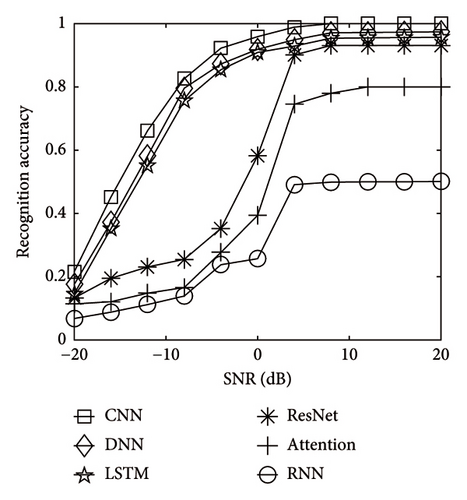
6.2. The Influence of Code Word Number, Code Length, and Code Rate on Algorithm
As shown in Figure 8, the accuracy increased as the number of code words increased, and for each curve, the accuracy reached its maximum at SNR. As number of code words aggrandized, the less it grew. It indicated that the number of code words had limited influence on the recognition accuracy. In Figure 9, with the continuous increase of SNR, the recognition result of code length 64 was optimal, attaining 100% first. In Figure 10, with the growth of SNR, the recognition result of bit rate 3/8 was the best, reaching 100% the earliest.
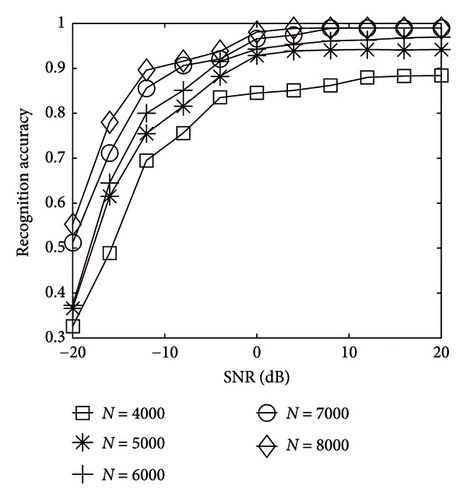
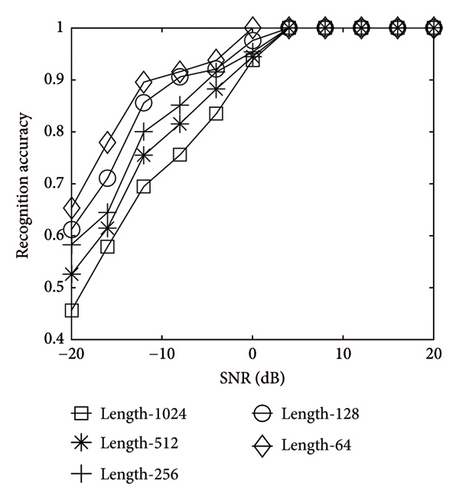
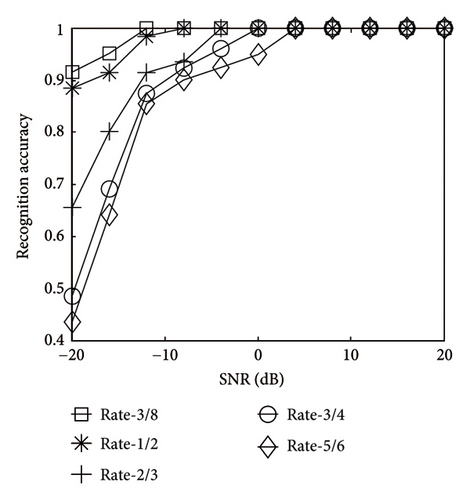
6.3. The Effect of the Loss Function
In Figures 11 and 12, converging bight of loss function when SNR was 3 dB can be quickly stabilized when a deterministic number of frequency of drilling were arrived.
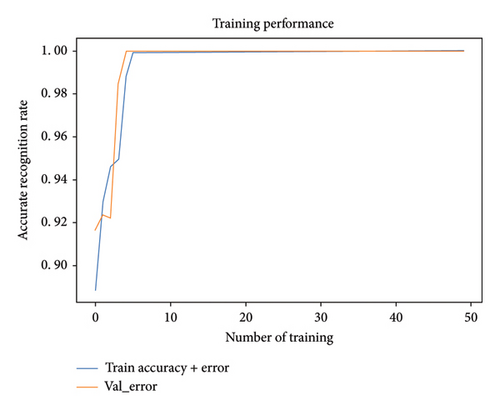
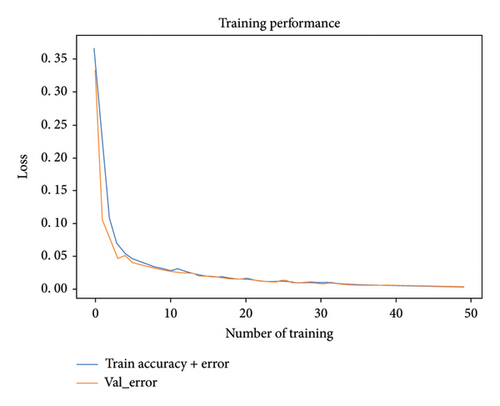
6.4. Accuracy of Code Categorization
Figure 13 presents the standardized confusion matrix of 5 kinds of encoding in 3 dB. The standardized confusion matrix showed that 5 kinds of convolutional codes may be discriminated in most cases. The CNN model presented in this paper can discriminate 5 different convolutional codes. Figure 14 presents the standardized confusion matrix of five kinds of encoding in 3 dB. The CNN model presented in this paper may also discriminate five similar convolutional codes and has certain accuracy. Figure 15 shows that the algorithm proposed in this paper had better recognition performance under low SNR, indicating that extracting features through the Euclidean algorithm combined with the improved CNN is more conductive to the recognition of various convolutional codes, especially under low SNR.
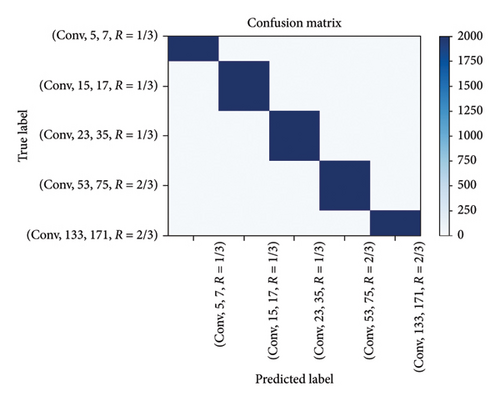
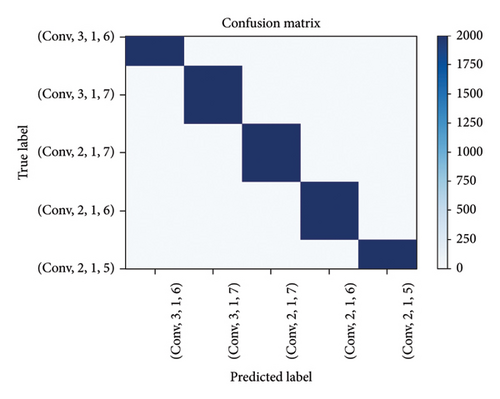
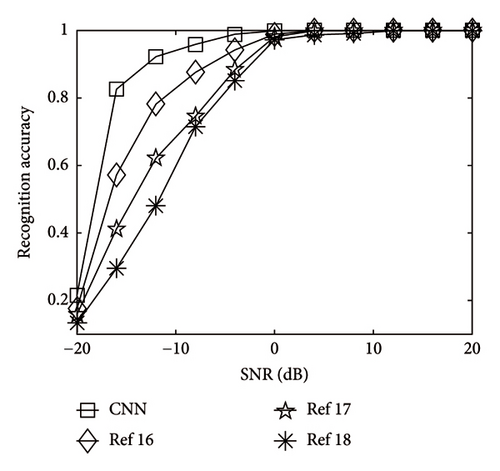
6.5. Operation Time Contrastion
Table 4 shows the operation time contrastion between CNN and the rest of 5 ways. The performance of the proposed CNN was the best.
| Ways | Operation time (ms) |
|---|---|
| CNN | 4.732 |
| DNN | 6.395 |
| LSTM | 12.576 |
| ResNet | 16.814 |
| Attention | 18.828 |
| RNN | 10.124 |
7. Conclusion
In this paper, five sorts of convolutional codes with various rates were produced by traditional coding ways. So as to achieve categorization and identification of convolutional codes with various rates in circumstances of low SNR, the feature coefficient of 5 kinds of convolutional codes with different rates was integrated into CNN so as to quickly identify the coding parameters of convolutional codes under low SNR. Experimental results showed that the suggested algorithm had strong results, indicating its efficiency and strong fault tolerance when the SNR was relatively small, in addition to good application prospects in noncooperative communication.
Disclosure
Intellectual property protection measures have been thoroughly discussed, and there are no impediments to its dissemination, including publication timing. Accordingly, we confrm our adherence to our institutions’ guidelines on intellectual property.
Conflicts of Interest
The authors declare no conflicts of interest.
Author Contributions
All authors have reviewed and approved the manuscript, and no supplementary contributors who meet authorship criteria have been excluded. The sequence of authors has been agreed upon mutually.
Funding
This work was supported by National Natural Science Foundation of China (no. 61671095, no. 61371164, no. 61975171, and no. 62201113), the Project of Key Laboratory of Signal and Information Processing of Chongqing (no. CSTC2009CA2003), the Natural Science Foundation of Chongqing (no. cstc2021jcyj-msxmX0836), the Research Project of Chongqing Educational Commission (nos. KJ1600427 and KJ1600429), Yibin University of College- Level Research and Cultivation Program (2019PY35), the Open Project Fund of Intelligent Terminal Key Laboratory of Sichuan Province of China under Grant SCITLAB-0020, the China Postdoctoral Science Foundation (no. 2023MD744168), and the Science and Technology Research Program of Chongqing Municipal Education Commission (no. KJQN202300625).
Acknowledgment
The authors extend their appreciation to the Image and Communication Signal Processing Innovation Team, School of Communications and Information Engineering, Chongqing University of Posts and Telecommunications for funding this work through National Natural Science Foundation of China (no. 62201113).
Open Research
Data Availability Statement
The data used to support the findings of this study are available on reasonable request from the corresponding author.




